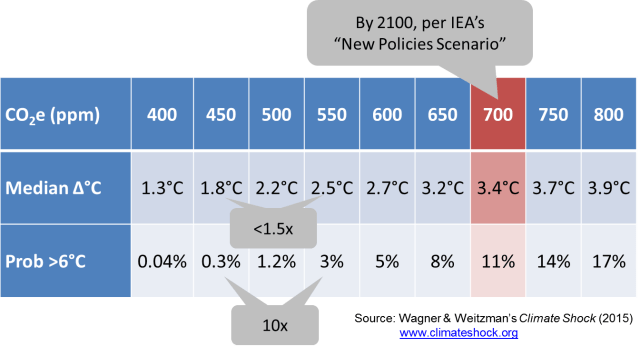Shortly after September 11, 2001, Vice President Dick Cheney gave us what has since become known as the One Percent Doctrine: “If there’s a 1% chance that Pakistani scientists are helping al-Qaeda build or develop a nuclear weapon, we have to treat it as a certainty in terms of our response.”
It inspired at least one book, one war, and many a comparison to the “precautionary principle” familiar to most environmentalists. It’s also wrong.
One percent isn’t certainty. This doesn’t mean that we shouldn’t take the threat seriously, or that the precautionary principle is wrong, per se. We should, and it isn’t.
Probabilities matter.
Take strangelets as one extreme. They are particles with the potential to trigger a chain reaction that would reduce the Earth to a dense ball of strange matter before it explodes, all in fractions of a second.
That’s a high-impact event if there ever was one. It’s also low-probability. Really low probability.
At the upper bound, scientists put the chance of this occurring at somewhere between 0.002% and 0.0000000002% per year, and that’s a generous upper bound.
That’s not nothing, but it’s pretty close. Should we be spending more on avoiding their creation, or figuring out if they’re even theoretically possible in the first place? Sure. Should we weigh the potential costs against the social benefit that heavy-ion colliders at CERN and Brookhaven provide? Absolutely.
Should we “treat it as a certainty” that CERN or Brookhaven are going to cause planetary annihilation? Definitely not.
Move from strangelets to asteroids, and from a worst-case scenario with the highest imaginable impact, but a very low probability, to one with significantly higher probability, but arguably much lower impact.
Asteroids come in all shapes and sizes. There’s the 20-meter wide one that unexpectedly exploded above the Russian city of Chelyabinsk in 2013, injuring mored than 1,400 people. And then there are 10-kilometer, civilization-ending asteroids.
Size matters.
No one would ask for more 20-meter asteroids, but they’re not going to change life on Earth as we know it. We’d expect a 10-kilometer asteroid, of the type that likely killed the dinosaurs 65 million years ago, once every 50-100 million years. (And no, that does not mean we are ‘due’ for one. That’s an entirely different statistical fallacy.)
Luckily, asteroids are a surmountable problem. Given $2 to $3 billion and 10 years, a National Academy study estimates that we could test an actual asteroid-deflection technology. It’s not quite as exciting as Bruce Willis in Armageddon, but a nuclear standoff collision is indeed one of the options frequently discussed in this context.
That’s the cost side of the ledger. The benefits for a sufficiently large asteroid would include not destroying civilization. So yes, let’s invest the money. Period.
Somewhere between strangelets and asteroids rests another high-impact event. Unchecked climate change is bound to have enormous consequences for the planet and humans alike. That much we know.
What we don’t know — at least not with certainty — could make things even worse. The last time concentrations of carbon dioxide stood where they are today, sea levels were up to 20 meters higher than today. Camels lived in Canada. Meanwhile global average surface temperatures were only 1 to 2.5 degrees Celsius (1.8 to 4.5 degrees Fahrenheit) above today’s levels.
Now imagine what the world would like with temperature of 6 degrees Celsius (11 degrees Fahrenheit) higher. There’s no other way of putting it than to suggest this would be hell on Earth.
And based on a number of conservative assumptions, my co-author Martin L. Weitzman and I calculate in Climate Shock that there might well be a 10% chance of an eventual temperature increase of this magnitude happening without a major course correction.
That’s both high-impact and high-probability.
Mr. Cheney was wrong in equating 1% to certainty. But he would have been just as wrong if he had said: “One percent is basically zero. We should just cross our fingers and hope that luck is on our side.”
So what to do? In short, risk management.
We insure our homes against fires and floods, our families against loss of life, and we should insure our planet against the risk of global catastrophe. To do so, we need to act — rationally, deliberately, and soon. Our insurance premium: put a price on carbon.
Instead of pricing carbon, governments right now even pay businesses and individuals to pump more carbon dioxide into the atmosphere due to various energy subsidies, increasing the risk of a global catastrophe. This is crazy and shortsighted, and the opposite of good risk management.
All of that is based on pretty much the only law we have in economics, the Law of Demand: price goes up, demand goes down.
It works beautifully, because incentives matter.
Gernot Wagner serves as lead senior economist at the Environmental Defense Fund and is co-author, with Harvard’s Martin Weitzman, of Climate Shock (Princeton, March 2015). This op-ed first appeared on Mashable.com.










 The surge in natural gas production that has reshaped the American energy landscape has many in the commercial transportation sector considering whether to start shifting their heavy-duty vehicle fleets from diesel to natural gas fuel. Many are looking to an advantage in carbon dioxide emissions to justify the higher cost and reduced fuel efficiency of a natural gas vehicle.
The surge in natural gas production that has reshaped the American energy landscape has many in the commercial transportation sector considering whether to start shifting their heavy-duty vehicle fleets from diesel to natural gas fuel. Many are looking to an advantage in carbon dioxide emissions to justify the higher cost and reduced fuel efficiency of a natural gas vehicle.

